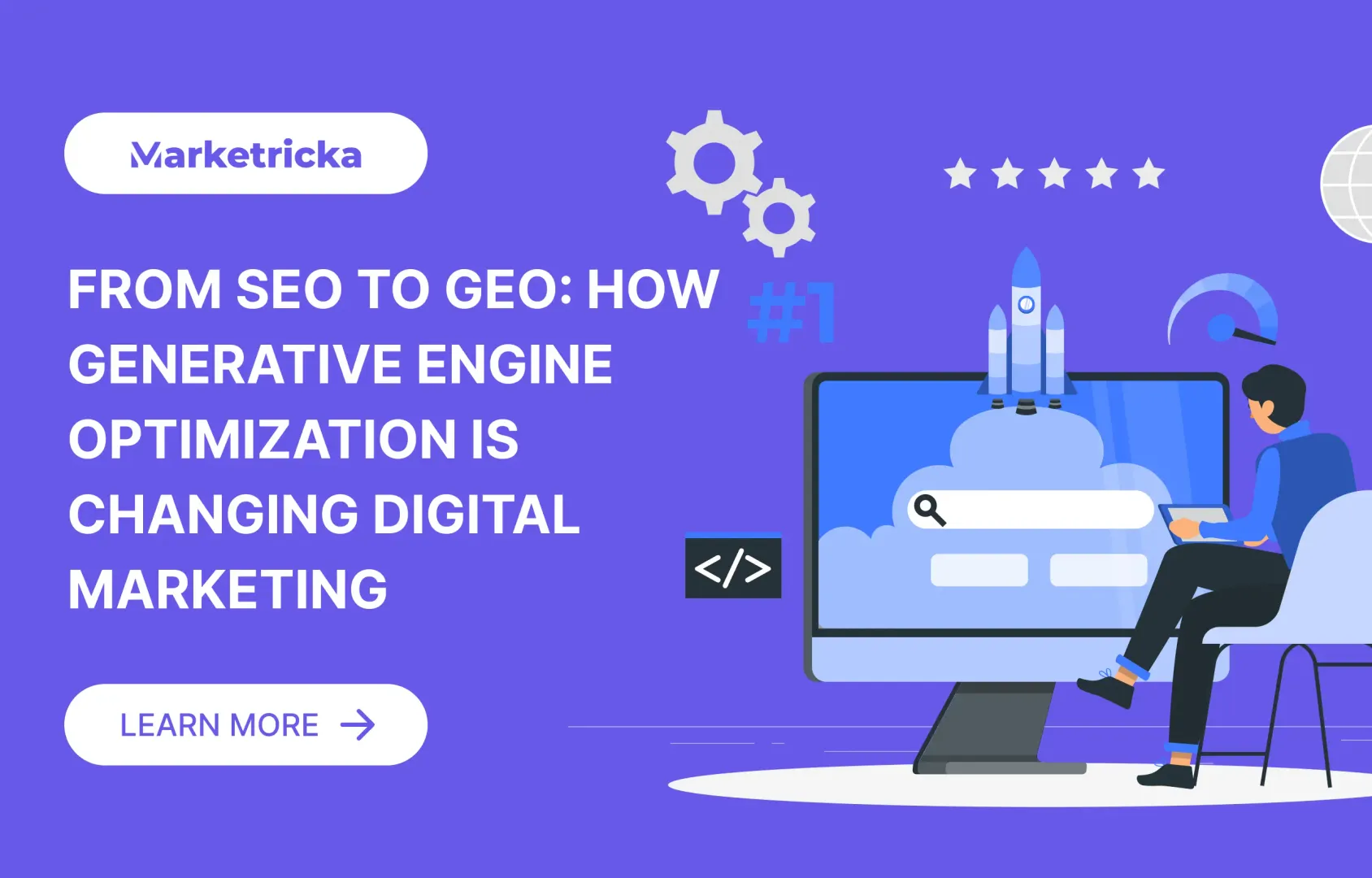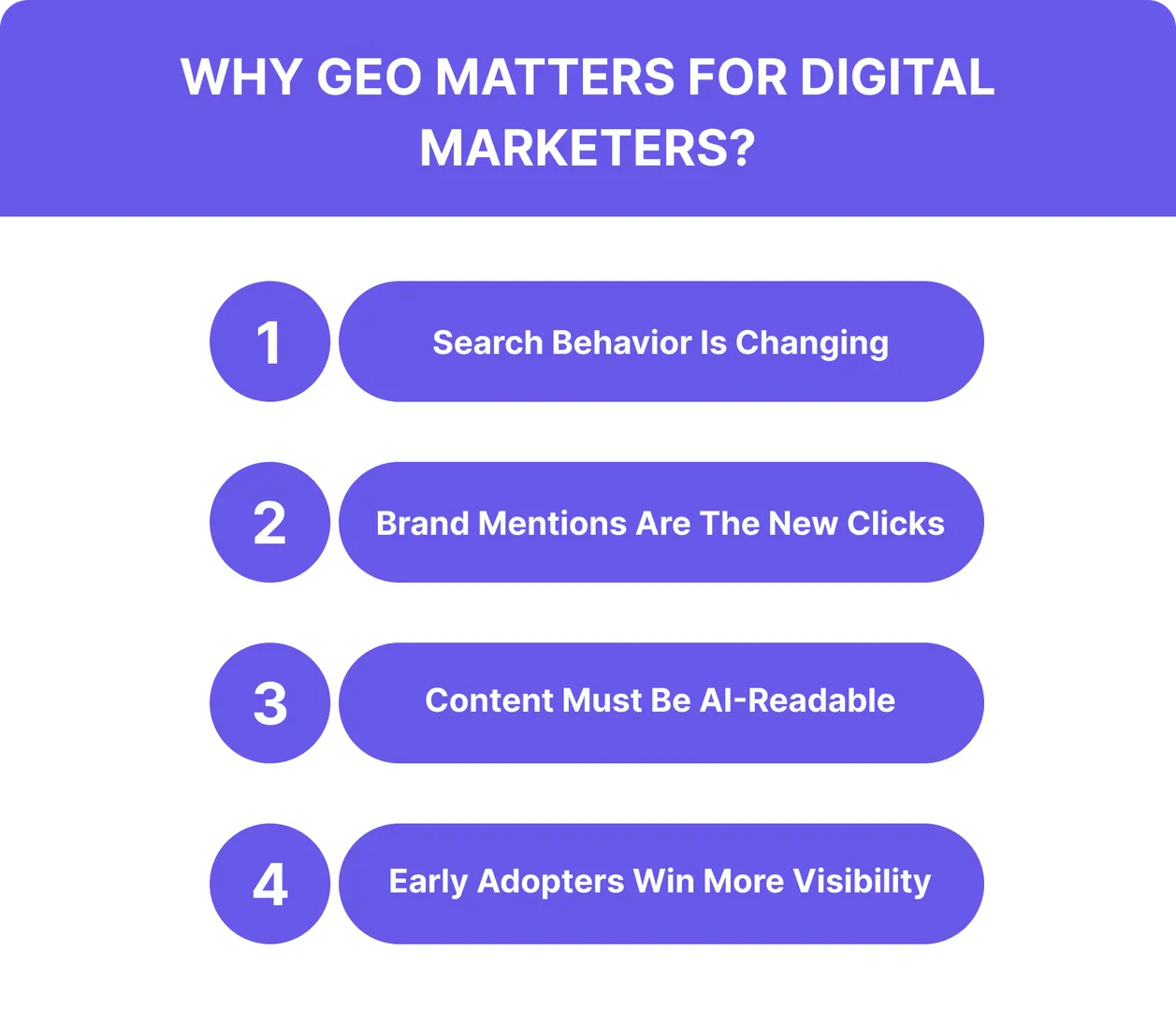From SEO to GEO: How Generative Engine Optimization Is Changing Digital Marketing in 2025
Learn how Generative Engine Optimization (GEO) is transforming digital marketing in 2025. Get proven strategies to optimize for ChatGPT, Perplexity & Google SGE.

Summary:
Ever searched for something online and got an answer instantly without even clicking a link? That’s the future of search. The way people find information is changing fast, and it’s all thanks to Generative Engine Optimization (GEO).
72% of professionals now use AI tools for research, and traditional organic traffic has decreased by 25% as users depend more on AI-generated answers. With Apple integrating Perplexity into Safari and ChatGPT reaching 200 million weekly users, mastering Generative Engine Optimization (GEO) isn't optional; it's essential for staying visible in 2025.
Instead of just ranking websites, search engines now generate answers using AI. For digital marketers, this means playing by a whole new set of rules. GEO is the next big thing, and if you want your brand to stay visible, it’s time to understand how generative AI in SEO is leading this shift.
What is Generative Engine Optimization?
GEO in Simple Terms: Instead of trying to rank #1 on Google, you're trying to get your content cited when ChatGPT, Perplexity, or Google SGE answers someone's question. It's about being the trusted source that AI recommends.
To succeed with GEO, focus on:
Writing clearly and concisely
Structuring content in a way that AI can follow
Focusing on helpful, human-friendly language
GEO helps your content show up in AI-generated answers, not just regular search results. It’s how brands stay visible as search becomes more conversational and intelligent.
How GEO Differs from Traditional SEO
Here’s a quick, clear breakdown of how Generative Engine Optimization (GEO) is different from traditional SEO:

The Numbers Behind the GEO Shift
Why This Matters Now:
78% of B2B buyers use AI tools for research in 2025
43% of users expect instant answers without clicking links
Average query length increased from 2.4 to 4.7 words since AI integration
52% of searches now involve follow-up questions in the same session
Users are getting answers directly from AI. Your content needs to feed those answers, not just attract clicks.
The Impact of Generative AI in Search Engines
Generative AI is transforming how people search, how results are shown, and how content is discovered. Instead of just displaying a list of links, modern search engines like Google SGE (Search Generative Experience), Bing with Copilot, and AI-first tools like Perplexity now provide direct answers, summaries, and even personalized insights all generated in real-time using large language models (LLMs).
This shift is changing user behavior. People are:
Asking longer, more complex questions
Expecting quick, conversational answers
Skipping traditional web links in favor of instant AI-generated responses
Search engines are no longer just indexes; they’re interactive answer engines powered by generative AI.
For businesses and content creators, this means optimizing content not just for rankings, but for understanding by AI. Your content needs to be structured, credible, and context-rich to be pulled into these AI answers even when users never click a link.
Why GEO Matters for Digital Marketers in 2025?
Here’s why GEO is important for digital marketers:

1. Search Behavior Has Changed
Users ask longer, conversational questions like "What's the difference between GEO and SEO for my business?" instead of typing "GEO vs SEO."
2. Citations Are the New Clicks
When ChatGPT or Perplexity mentions your brand as a source, you build authority even without website visits.
3. Early Adopter Advantage
Only 23% of marketers are optimizing for AI search. Start now and get ahead of your competition.
4. Future-Proof Your Strategy
Traditional search traffic is declining. GEO ensures you stay visible as users move to AI platforms.
5 Simple Strategies to Optimize for Generative Engines
Strategy #1: Write Like You're Answering Questions
Use headings like "What is GEO?" and "How does GEO work?"
Start each section with a direct answer
Use conversational language, not confusing or formal words
Strategy #2: Structure Your Content Clearly
Use bullet points and numbered lists
Add TL;DR summaries at the top of long sections
Break up long paragraphs into shorter ones
Strategy #3: Include Facts and Statistics
Add specific numbers and data points
Cite credible sources and studies
Update information regularly to stay current
Strategy #4: Optimize for Voice and Conversational Search
Target phrases like "how to optimize for GEO" instead of just "GEO optimization"
Answer the questions your audience actually asks
Use natural, spoken language
Strategy #5: Build Topic Authority
Create multiple pieces of content on related topics
Link between your articles on the same subject
Demonstrate expertise through detailed, accurate information
Challenges and Limitations of GEO
GEO is powerful, but it's not without challenges. Here's what you need to watch out for and how to handle each issue:

Unpredictable Ranking Signals
Unlike traditional SEO, where you can depend on keywords and backlinks to help boost your rankings, generative AI focuses more on the meaning, tone, and overall quality of the content. But since it doesn’t clearly show how or why it ranks certain content, it becomes difficult to figure out what’s actually working and why.
Limited Feedback Loop
With generative engines like ChatGPT or Perplexity, there’s no clear analytics or performance dashboard like you’d find with Google Search Console. As a result, it’s hard to know whether your content is actually working or just getting lost in the noise.
Risk of Generic Content
Depending too heavily on AI-generated copy can lead to content that sounds polished but lacks brand voice or originality, reducing trust and engagement.
Always Changing Systems
Generative engines are updated all the time, so what helps your content get noticed today might not work tomorrow. That’s why your strategy needs to stay flexible and open to trying new things.
How to Measure GEO Success
Track These Metrics:
Brand Mentions
How often do AI tools mention your brand or cite your content
Use Google Alerts to track mentions across platforms
Direct Traffic Increases
More people are searching for your brand directly
Increases in branded keyword searches
Authority Signals
Getting quoted or referenced by AI platforms
Being cited as a source in AI-generated answers
Engagement Quality
Longer time spent on your content
More follow-up questions and deeper engagement
Simple Tools to Use:
Google Search Console (free)
Google Alerts for brand monitoring (free)
Semrush for competitive analysis
Brand Mentions for AI platform tracking
Conclusion
Generative Engine Optimization isn't replacing traditional SEO; it's the next evolution. As more people use ChatGPT, Perplexity, and Google SGE for answers, brands that optimize for these platforms will stay visible and relevant.
Your Action Plan:
Start Small: Pick one piece of content and optimize it using the 5 strategies above
Monitor Results: Set up Google Alerts for your brand and track mentions
Scale Gradually: Apply GEO principles to more of your content over time
Stay Updated: Follow AI platform changes and adjust your strategy